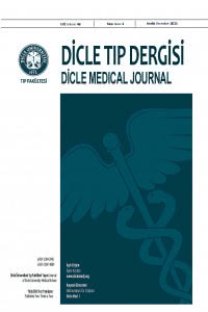Postmenopozal Kadınlarda Kemik Mineral Dansitometri Değerleri ile Hematolojik Parametrelerin Karşılaştırılması
The Comparison of Bone Mineral Densitometry Values and Hematological Parameters in Postmenopausal Women
___
- 1.Consensus development conference: diagnosis,prophylaxis, and treatment of osteoporosis. Am JMed. 1993; 94: 646-50.
- 2.Harvey N, Dennison E, Cooper C. Osteoporosis:impact on health and economics. Nat RevRheumatol. 2010; 6: 99-105.
- 3.Yun AJ, Lee PY. Maldaptation of the link betweeninflammation and bone turnover may be a keydeterminant of osteoporosis. Med Hypotheses.2004; 63: 532-7.
- 4.Manolagas SC, Jilka RL. Bone marrow, cytokines,and bone remodeling. Emerging insights into thepathophysiology of osteoporosis. N Engl J Med.1995; 332: 305-11.
- 5.Lei Z, Xiaoying Z, Xingguo L. Ovariectomy-associated changes in bone mineral density andbone marrow haematopoiesis in rats. Int J ExpPathol. 2009; 90: 512-9.
- 6.Kimble RB, Matayoshi AB, Vannice JL, et al.Simultaneous block of interleukin-1 and tumornecrosis factor is required to completely preventbone loss in the early postovariectomy period.Endocrinology. 1995; 136: 3054-61.
- 7. Nanes MS. Tumor necrosis factor-alpha: molecularand cellular mechanisms in skeletal pathology. Gene.2003; 321: 1-15.
- 8.Kutlucan A, Tunc S, Baltacı D, ve ark. Behçethastalarında serum TNF- α veosteoprotegerin düzeyi ve kemik kitle yoğunluğu.Dicle Tıp Dergisi. 2012; 39: 325-30.
- 9.Barbour KE, Boudreau R, Danielson ME, et al.Inflammatory markers and the risk of hip fracture:the Women's Health Initiative. J Bone Miner Res.2012; 27: 1167-76.
- 10.Papa A, Emdin M, Passino C, et al. Predictivevalue of elevated neutrophil-lymphocyte ratio oncardiac mortality in patients with stable coronaryartery disease. Clin Chim Acta. 2008; 395: 27-31.
- 11.Can C. Correlation of (18F) FDG PET/CTParameters with Haematological Parameters inEsophageal Cancers and the Effect of TheseParameters on Survival. Dicle Tıp Dergisi, 2020; 47:556-67.
- 12.Torun S, Tunc BD, Suvak B, et al. Assessment ofneutrophil-lymphocyte ratio in ulcerative colitis: apromising marker in predicting disease severity.Clin Res Hepatol Gastroenterol. 2012; 36: 491-7.
- 13.Zengin O, Onder ME, Kalem A, et al. Newinflammatory markers in early rheumatoid arthritis.Z Rheumatol. 2018; 77: 144-50.
- 14.Sun X, Liu X, Liu J, et al. Preoperative neutrophil-to-lymphocyte ratio plus platelet-to-lymphocyteratio in predicting survival for patients with stage I-II gastric cancer. Chin J Cancer. 2016; 35: 57.
- 15.Tanrikulu AC, Abakay A, Komek H, Abakay O.Prognostic value of the lymphocyte-to-monocyteratio and other inflammatory markers in malignantpleural mesothelioma. Environ Health Prev Med.2016; 21: 304-11.
- 16.Öztürk ZA, Yesil Y, Kuyumcu ME, et al. Inverserelationship between neutrophil lymphocyte ratio(NLR) and bone mineral density (BMD) in elderlypeople. Arch Gerontol Geriatr. 2013; 57: 81-5.
- 17.Huang C, Li S. Association of blood neutrophillymphocyte ratio in the patients withpostmenopausal osteoporosis. Pak J Med Sci. 2016;32: 762-5.
- 18.Liu W, Huang Z, Tang S, Wei S, Zhang Z. Anevaluation of homocysteine, C-reactive protein, lipidlevels, neutrophils to lymphocyte ratio in postmenopausal osteopenic women. Gynecol Endocrinol. 2016; 32: 446-8.
- 19.Yilmaz H, Uyfun M, Yilmaz TS, et al. Neutrophil-lymphocyte ratio may be superior to C-reactiveprotein for predicting the occurrence ofpostmenopausal osteoporosis. Endocr Regul. 2014;48: 25-33.
- 20.Lee SH, Ryu SY, Park J, et al. The Relationship ofNeutrophil-Lymphocyte Ratio and Platelet-Lymphocyte Ratio with Bone Mineral Density inKorean Postmenopausal Women. Chonnam Med J.2019; 55: 150-5.
- 21.Koseoglu SB. Bone loss & platelet-to-lymphocyteratio. Biomark Med. 2017; 11: 5-10.
- 22.Eroglu S, Karatas G. Platelet/lymphocyte ratio isan independent predictor for osteoporosis. SaudiMed J. 2019; 40: 360-6.
- 23.Kim HL, Cho HY, Park IY, et al. The positiveassociation between peripheral blood cell countsand bone mineral density in postmenopausalwomen. Yonsei Med J. 2011; 52: 739-45.
- 24.Korkmaz U, Korkmaz N, Yazici S, et al. Anemia asa risk factor for low bone mineral density inpostmenopausal Turkish women. Eur J Intern Med.2012; 23: 154-8.
- 25.Li L, Ge JR, Chen J, et al. Association of bonemineral density with peripheral blood cell countsand hemoglobin in Chinese postmenopausalwomen: A retrospective study. Medicine(Baltimore). 2020; 99: e20906.
- ISSN: 1300-2945
- Yayın Aralığı: 4
- Başlangıç: 1963
- Yayıncı: Cahfer GÜLOĞLU
Yunus GÜZEL, Ali UYAR, Şadiye ALTUN TUZCU, İbrahim KAPLAN, Serhat ERGÜL, Mehmet Serdar YILDIRIM, Hikmet SOYLU, Bekir TAŞDEMİR
What Do Medical Students Think About HIV/AIDS? Student thoughts on HIV / AIDS
Elif ERDEM GU ZEL, Nalan KAYA, AHMET TEKTEMUR, Hilal ACAY, Ayfer YILDIRIM
Malign Plevral Mezotelyoma Tanısında 18F-FDG PET/BT Görüntülemenin Rolü
A Rare Cause of Hydronephrosis: Retrocaval ureter
Cihat UZUNKÖPRÜ, Enise Nur ÖZLEM TİRYAKİ, Muhammed Mücahit TİRYAKİ
Morbid Obez Hastalarda Obezite Medikal Tedavi Başarısı ile Başlangıç HbA1c Düzeyi İlişkisi
Figen KOÇ DİREK, M. Cudi TUNCER, Engin DEVECİ, Beran YOKUŞ, Cemal NAS, Dilek AYGÜL KEŞİM
Pınar AKIN KABALAK, İlker ÖZDEMİR, Hatice TASLAK, Derya KIZILGÖZ, Ülkü YILMAZ
